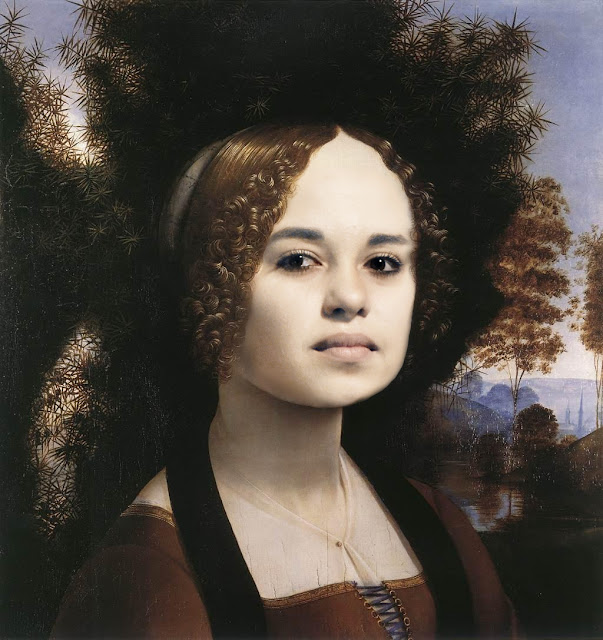Assignment #7:

The Renaissance began in
Italy in the 14th Century. By
the 16th Century it spread to the North, including England, and
ended in the mid-17th Century.
The Renaissance affected literature, philosophy, music, politics,
science, religion, art, and other aspects in culture. Renaissance artists searched for realism and
human emotion in their art through the development of perspective, light,
shadow, and human anatomy. The artists
desired to depict the beauty of nature by developing a manner of painting that
was unpredictably naturalistic, 3-D, life-like, and classicising. Artists incorporated a greater sense of
light and colour through new mediums. Some
techniques that they used were: Humanism
and Perspective - Where the idea of perspective it to create a three-dimensional
appearance on a two-dimensional object. Sfumato - The idea was to blend one shade into
another to create the appearance of depth, form and volume. Chiaroscuro - Using the contrast of light and
dark to create dimension. There are many
more techniques, and these techniques are still known and used in modern day. Giiotto was one of the first to paint in this
new style. Giotto's paintings began to
show real emotion, perspective and solidity.
Leonardo da Vinci and Michelangelo are also famous artist of this time,
with their work still famous around the world.
The ideas and techniques of these artists were copied and improved upon
by other artist ad inventors. This
really improved and expanded the sense of artistry and the overall affect of
art in the world at that time. It turned art into more than just a craft. It turned art into what it is today. A
lifestyle. It changed the spectator's
view of art from just a show of skills to a telling of a story.
The original painting Ginevra de'Benei by Leonardo Da
Vinci. Givevra de'Benei was an
aristocrat from 15th-century Florence, and the portrait was painted
to commemorate her marriage. "This
portrait of Ginevra shows the female with a marble-like skin and hair styled in
ringlets framing a face portraying a sulky and proud facial
expression." She was 17 and her
fiancé was twice her age. It is a significant painting for Leonardo Da
Vinci because his paintings were so rare.
The alabaster smoothness of her face was an effect that Leonardo
accomplished by smoothing the surface of the paint with his own hands. Leonardo was the first painter to have the
perfect control over his medium to achieve the look of light and shade to merge
them imperceptibly. A juniper bush can be seen in the background
of the portrait, which makes sense as 'Ginevra' in Italian means juniper. On the back of the painting is a 'heraldic
motif' that includes a sprig of juniper encircled by a wreath of laurel and
palm. This painting is the first
psychological portrait ever painted and one of the first three-quarter or
frontal view of the sitter. Leonardo's
innovation was developed during his painting of 4 women, where each woman
expresses different moods. In this
painting, Leonardo shows us the 'enigmatic melancholy' of Ginevra de
'Benei. Sadness had rarely been
represented in portraiture before the 17th century, and even then,
the tragic view of life was usually conveyed through portraits of men, not
women.
Leonardo da Vinci was (and still is) one of the most
famous Renaissance painters. He was born
in 1452 in the village of Vinci, and began his career working for a master
painter in Florence. As Leonardo's fame
grew, he was recognized as truly a "Renaissance Man", being skilled
in many fields; he as a scientist, an inventor, as well as an artist. He had major influences in the design of
hydraulics, mechanical engineering, structural engineering, and advanced
weaponry all used during this time period.
He also influenced science and mathematics in his use of geometry and
his diagrams of the human anatomy (which were illegal at the time), bringing
knowledge in medical science which were used then, as well into modern times. As an artist, he rejected using the medium of
tempera paints, and chose oil instead.
Contrary to the beliefs previous artists, Leonardo discovered that
objects were not comprised of outlines, but were 3-D, defined by light and
shadow. He also used perspective, and
saw that an object's detail and colour changed as it receded into the
distance. As a perfectionist, he sought
out the 'ideal; human figure through studies of the physical proportions of
men, women, and children. Today,
Leonardo's paintings are displayed and admired all over the world, inspiring
aspiring artists to break the rules a little, and open their minds to infinite
possibilities.
Original Painting:





